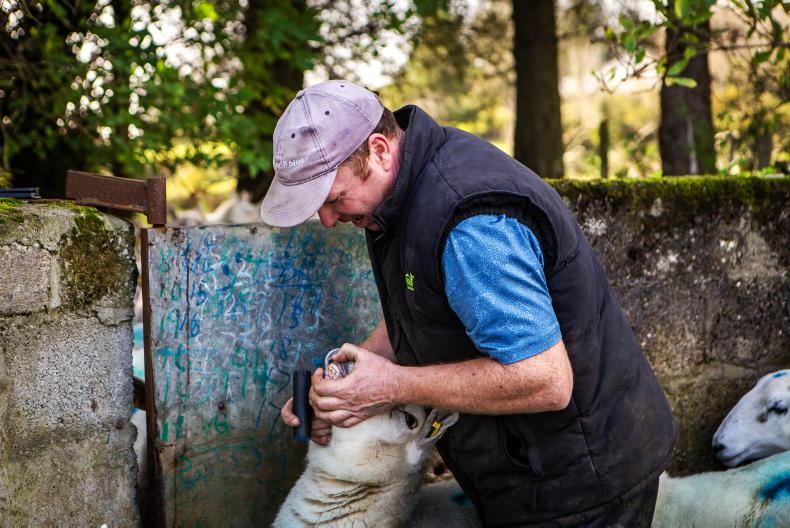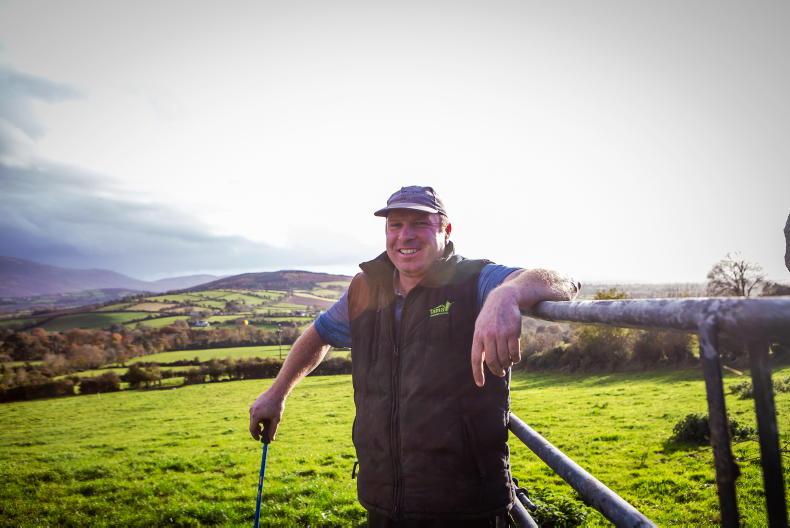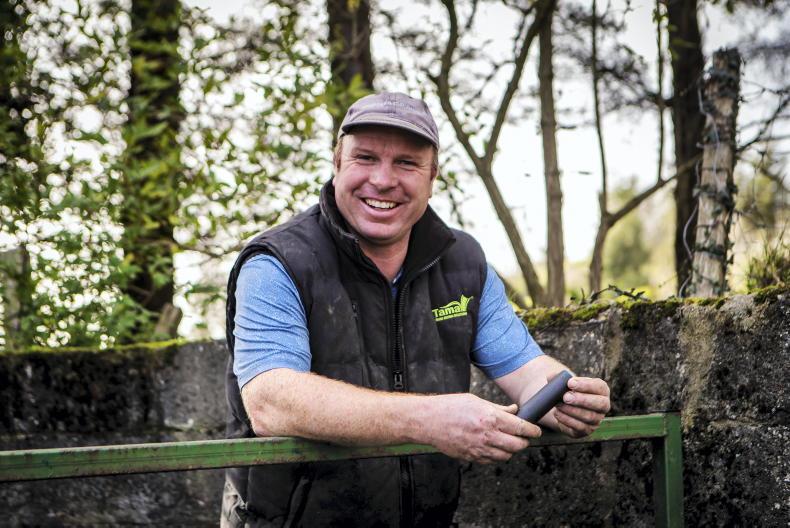I’m from a place called Rathanna, Borris, Co Carlow. It’s just right under the Blackstairs Mountains, under Mount Leinster. A lovely part of the country.
I mainly have hill sheep, Cheviot ewes. I run them on the Blackstairs and I cross them with Suffolk rams to produce a sheep called the Borris ewe.
It’s a very famous sheep from the area near the Blackstairs Mountains. People from all over the country come to buy this breeding ewe at our sales in August every year.
My flock
I put the ewe hoggets to the hill in June every year. I wean the ewes in July and I put all the ewes to the hill then. The ewes come down from the Blackstairs in October and at the end of October they go with the rams.

Tomas McCarthy runs a flock of hill sheep on the Blackstairs Mountains. \ Claire Nash
I go up every few weeks, walk along the hill and do as good a check as I can. I keep an eye on them that way but it’s hard to herd a mountain in comparison to a normal field.
We always have good dogs. It’s a must to have a good dog working the mountains. I’ve trained dogs but then you have to have particular good breeding in the dog before you train it.
The couple of dogs I work the mountains with are bred down from hill dogs over the years. Breeding is a big factor in having good dogs as well as training.
A shearing start
I lost my father through a farm accident when I was only 15. A local man came here to work on the farm. He helped on the farm for a couple of years until I finished school at 17.
He was a sheep shearer and a smoker. When he used to stop for a smoke he’d say: “Get in and shear a sheep.” That’s how simply it started.
I started when I was about 16 getting into shearing an odd sheep. Every year I realised I was getting a little bit better at it. I got fond of it.
I bought my own machine when I was 17. At 18 and I was shearing a few numbers here and there, you know the way. I’ve been shearing a few sheep for hire every year since I was 18 years of age.
I’m still shearing but not as much as last year. The shearing works out very well with my own farm because I can take a day off and do a day at home whenever it suits.

Tomas McCarthy has been shearing sheep since he was 16. \ Claire Nash
On a good day we’re doing 200 and over, depending on the sheep quality and the farm setup. I start shearing around 10 May every year. Some shearers start earlier. We’re gone a bit quieter now as we’re finishing up very soon.
Price of wool
I’ve seen the price of wool in my lifetime go from €1.70/kg down to this year where farmers are telling me they can’t get rid of it. When I was younger, people had great respect for wool and they’d be picking it up and packing it. They knew there was a few pound to be made from it, you know.
I believe in New Zealand and Australia wool is still worth good money
In recent years, especially this year of all years, people have lost complete interest in it because of the lack of value. It’s worth so little.
I can’t understand why there’s nothing being introduced to pick that price back up a bit, because I believe in New Zealand and Australia wool is still worth good money. People have lost all heart in the wool aspect of shearing because it’s worth so little.
The shearer is costing farmers money. For a lot of years the wool was covering the cost of shearing the sheep and maybe even a few pound profit.
At present the farmer is losing money when they see the shearer coming, so obviously it’s a disheartening trade.
Borris Ewe Breeders’
I’ve been going to the mart in Borris since I was about 10 years of age and I’m 42 now. It’s where we hold the Borris Ewe Breeders’ show and sale every year. This year the 58th annual one will take place on 14 August.
I’m involved with the Borris Ewe Breeders’ for the last 25 year. I’m treasurer at the moment. People come from all over the country to buy this breeding ewe at our sales.
Judges will come and judge the sheep in the morning. Prizes will be presented. Buyers and customers will arrive then in the morning time as well
There are 1,200 breeding ewes and 800 ewe lambs of the top quality on the day. Judges will come and judge the sheep in the morning. Prizes will be presented. Buyers and customers will arrive then in the morning time as well. They’ll view the sheep.
It’s mainly people with lowland sheep buy these hill-type ewes because they thrive in other counties away from Carlow and produce good stock. Some people love coming to Borris just to see the quality of the sheep. If you’re a sheep person it’s something different, they’re a different breed. They look shocking well on the day presented by all members of the association.
I’d be happier to see a good trade for everyone
It’s a day you’d be looking forward to but it’s a busy day for all presenting sheep as well. Then if the sale is good, if it’s a good trade, you’re very happy afterwards.
I had winners on a good few occasions in the breeding ewe section but I’d be happier to see a good trade for everyone. That’s the most important thing.
Read more
My Country Living: Shillelagh making in Co Wicklow
My Country Living: graphic design and farm safety
I’m from a place called Rathanna, Borris, Co Carlow. It’s just right under the Blackstairs Mountains, under Mount Leinster. A lovely part of the country.
I mainly have hill sheep, Cheviot ewes. I run them on the Blackstairs and I cross them with Suffolk rams to produce a sheep called the Borris ewe.
It’s a very famous sheep from the area near the Blackstairs Mountains. People from all over the country come to buy this breeding ewe at our sales in August every year.
My flock
I put the ewe hoggets to the hill in June every year. I wean the ewes in July and I put all the ewes to the hill then. The ewes come down from the Blackstairs in October and at the end of October they go with the rams.

Tomas McCarthy runs a flock of hill sheep on the Blackstairs Mountains. \ Claire Nash
I go up every few weeks, walk along the hill and do as good a check as I can. I keep an eye on them that way but it’s hard to herd a mountain in comparison to a normal field.
We always have good dogs. It’s a must to have a good dog working the mountains. I’ve trained dogs but then you have to have particular good breeding in the dog before you train it.
The couple of dogs I work the mountains with are bred down from hill dogs over the years. Breeding is a big factor in having good dogs as well as training.
A shearing start
I lost my father through a farm accident when I was only 15. A local man came here to work on the farm. He helped on the farm for a couple of years until I finished school at 17.
He was a sheep shearer and a smoker. When he used to stop for a smoke he’d say: “Get in and shear a sheep.” That’s how simply it started.
I started when I was about 16 getting into shearing an odd sheep. Every year I realised I was getting a little bit better at it. I got fond of it.
I bought my own machine when I was 17. At 18 and I was shearing a few numbers here and there, you know the way. I’ve been shearing a few sheep for hire every year since I was 18 years of age.
I’m still shearing but not as much as last year. The shearing works out very well with my own farm because I can take a day off and do a day at home whenever it suits.

Tomas McCarthy has been shearing sheep since he was 16. \ Claire Nash
On a good day we’re doing 200 and over, depending on the sheep quality and the farm setup. I start shearing around 10 May every year. Some shearers start earlier. We’re gone a bit quieter now as we’re finishing up very soon.
Price of wool
I’ve seen the price of wool in my lifetime go from €1.70/kg down to this year where farmers are telling me they can’t get rid of it. When I was younger, people had great respect for wool and they’d be picking it up and packing it. They knew there was a few pound to be made from it, you know.
I believe in New Zealand and Australia wool is still worth good money
In recent years, especially this year of all years, people have lost complete interest in it because of the lack of value. It’s worth so little.
I can’t understand why there’s nothing being introduced to pick that price back up a bit, because I believe in New Zealand and Australia wool is still worth good money. People have lost all heart in the wool aspect of shearing because it’s worth so little.
The shearer is costing farmers money. For a lot of years the wool was covering the cost of shearing the sheep and maybe even a few pound profit.
At present the farmer is losing money when they see the shearer coming, so obviously it’s a disheartening trade.
Borris Ewe Breeders’
I’ve been going to the mart in Borris since I was about 10 years of age and I’m 42 now. It’s where we hold the Borris Ewe Breeders’ show and sale every year. This year the 58th annual one will take place on 14 August.
I’m involved with the Borris Ewe Breeders’ for the last 25 year. I’m treasurer at the moment. People come from all over the country to buy this breeding ewe at our sales.
Judges will come and judge the sheep in the morning. Prizes will be presented. Buyers and customers will arrive then in the morning time as well
There are 1,200 breeding ewes and 800 ewe lambs of the top quality on the day. Judges will come and judge the sheep in the morning. Prizes will be presented. Buyers and customers will arrive then in the morning time as well. They’ll view the sheep.
It’s mainly people with lowland sheep buy these hill-type ewes because they thrive in other counties away from Carlow and produce good stock. Some people love coming to Borris just to see the quality of the sheep. If you’re a sheep person it’s something different, they’re a different breed. They look shocking well on the day presented by all members of the association.
I’d be happier to see a good trade for everyone
It’s a day you’d be looking forward to but it’s a busy day for all presenting sheep as well. Then if the sale is good, if it’s a good trade, you’re very happy afterwards.
I had winners on a good few occasions in the breeding ewe section but I’d be happier to see a good trade for everyone. That’s the most important thing.
Read more
My Country Living: Shillelagh making in Co Wicklow
My Country Living: graphic design and farm safety








 This is a subscriber-only article
This is a subscriber-only article










SHARING OPTIONS: